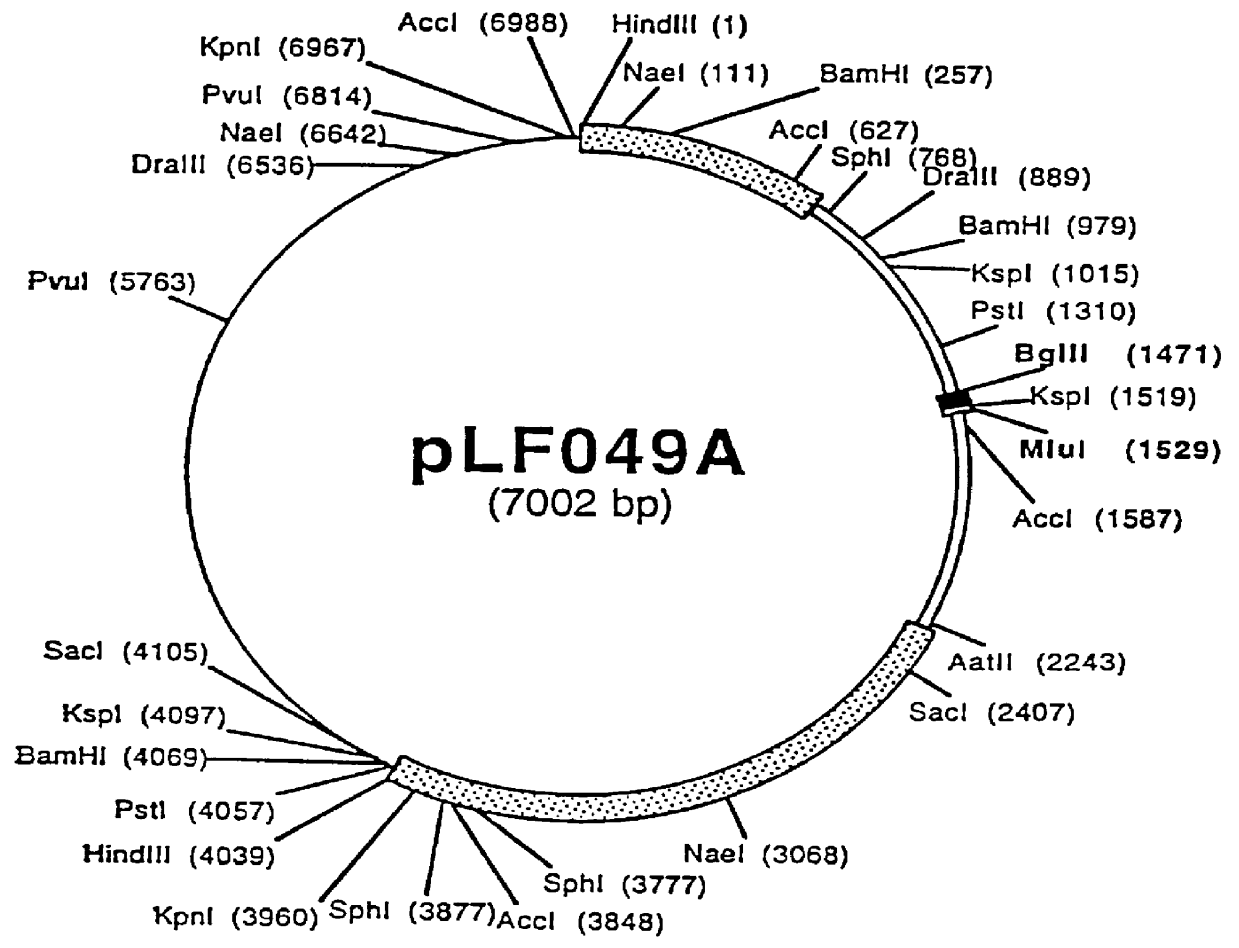Recombinant canine adenoviruses, method for making and uses thereof
a technology of adenoviruses and canine adenoviruses, which is applied in the field of recombinant canine adenoviruses, can solve the problems of limited amount of exogenous dna that can be inserted into the cav genome, and the insert size limitation of the cav genom
- Summary
- Abstract
- Description
- Claims
- Application Information
AI Technical Summary
Benefits of technology
Problems solved by technology
Method used
Image
Examples
example 1
Virus and Cell Line Identifications
The described stock of canine adenovirus type 2 (CAV2) was produced at Rhone Merieux Inc. (Athens, Ga.) under the reference CAV2 Lot #0830 pool--033093, with a titer of 10.sup.7.4 TCID.sub.50 / ml. Madin and Darby canine kidney (MDCK) cell line was also provided by Rhone Merieux Inc. CAV2 is commercially available from Rhone Merieux Inc. as a canine vaccine.
example 2
MDCK cell suspensions were seeded in MEM (Gibco, Grand Island, N.Y.) supplemented with 7.5% fetal bovine serum (Sigma, St Louis, Mo.), sodium pyruvate (Gibco, 1 mM final), glutamine (Gibco, 2 mM final), penicillin (Gibco, 50 U / ml), streptomycin (Gibco, 50 mg / ml) and non essential amino acids (NEA)(Gibco, 0.1 mM final) and cultured at 37.sup.itch in 5% CO.sub.2. Confluent MDCK cells were infected with serial dilutions of CAV2 and cultured under a 0.6% agarose overlay at 37.sup.itch in 5% CO.sub.2. CAV2 was subjected to several rounds of plaque purification. A plaque purified CAV2 was amplified in a T25 MDCK flask. When the culture CPE was complete, infected cells were collected and their CAV2 content was titrated on MDCK cell monolayers under agarose. The virus stock was further amplified by infecting a confluent T175 MDCK flask with a multiplicity of infection (MOI) of 0.1. The titre of the T175 MDCK flask amplified virus was established to be 10.sup.8 p.f.u...
example 3
Viral DNA Purification
Roller bottles containing confluent MDCK cell monolayers (10.sup.8 cells / bottle) were infected at a MOI of 0.1 pfu / cell with plaque purified CAV2 virus. Three days later the infected monolayer were harvested and subjected to low speed centrifugation (1 Kg, 15 minutes, 15.degree. C.). The cell pellets were stored at -70.degree. C. The frozen pellets were subsequently thawed at 37.degree. C. and carefully resuspended in 10 mM Tris HCl pH 8.0 and 10 mM EDTA buffer (35 ml / 10.sup.8 cells) to limit cellular DNA shearing. SDS was added to the resuspended pellets to a final concentration of 1%. After 15 minutes incubation at room temperature NaCl was added to a concentration of 1.25 M. After 3 hours incubation at 4.degree. C. the material was centrifuged at 25 Kg for 20 minutes at 4.degree. C. Dense white pellets containing salts and cellular DNA were discarded and supernatants were digested with Proteinase K (300 .mu.g / ml final concentration) at 42.degree. C. for 4 ho...
PUM
| Property | Measurement | Unit |
|---|---|---|
| reaction rates | aaaaa | aaaaa |
| diameters | aaaaa | aaaaa |
| diameter | aaaaa | aaaaa |
Abstract
Description
Claims
Application Information
 Login to View More
Login to View More - R&D
- Intellectual Property
- Life Sciences
- Materials
- Tech Scout
- Unparalleled Data Quality
- Higher Quality Content
- 60% Fewer Hallucinations
Browse by: Latest US Patents, China's latest patents, Technical Efficacy Thesaurus, Application Domain, Technology Topic, Popular Technical Reports.
© 2025 PatSnap. All rights reserved.Legal|Privacy policy|Modern Slavery Act Transparency Statement|Sitemap|About US| Contact US: help@patsnap.com



